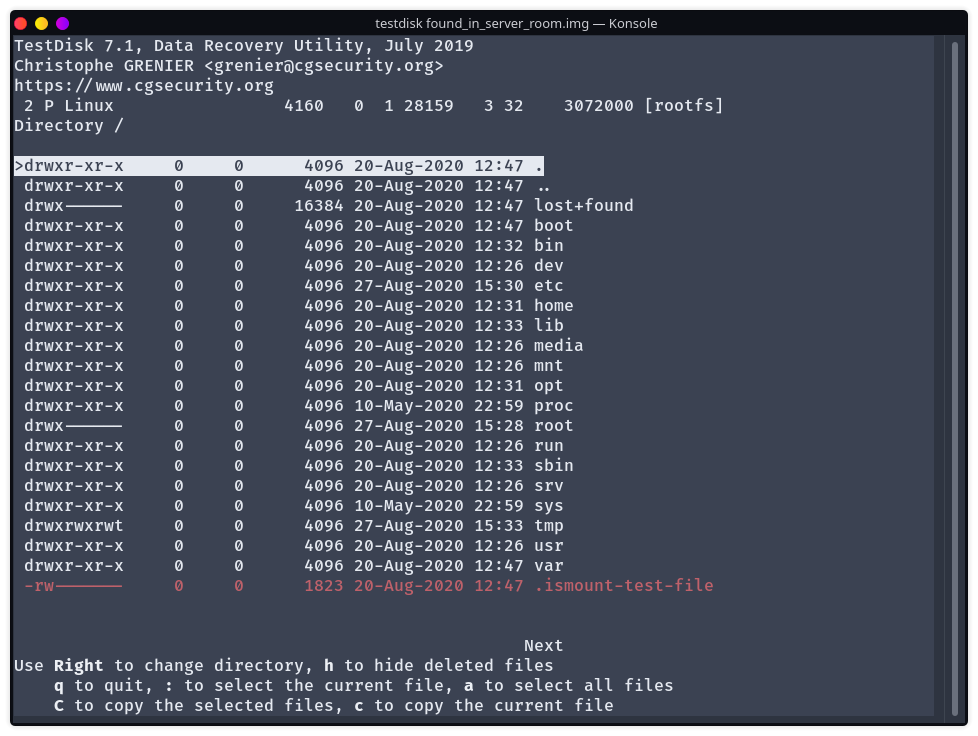Writeup DG’hAck: Server Room
This challenge starts with a file, found_in_server_room.img.gz. Let’s first try to find what this file is:
$ gunzip found_in_server_room.img.gz
$ file found_in_server_room.img
found_in_server_room.img: DOS/MBR boot sector; partition 1 : ID=0xc, start-CHS (0x40,0,1), end-CHS (0x3ff,3,32), startsector 8192, 524288 sectors; partition 2 : ID=0x83, start-CHS (0x3ff,3,32), end-CHS (0x3ff,3,32), startsector 532480, 3072000 sectors
So this is a disk image. Let’s try mounting it!
$ mkdir mnt
$ sudo mount found_in_server_room.img mnt
NTFS signature is missing.
Failed to mount '/dev/loop0': Invalid argument
The device '/dev/loop0' doesn't seem to have a valid NTFS.
Maybe the wrong device is used? Or the whole disk instead of a
partition (e.g. /dev/sda, not /dev/sda1)? Or the other way around?
Huh.
$ fdisk -l found_in_server_room.img
Disk found_in_server_room.img: 1.72 GiB, 1845493248 bytes, 3604479 sectors
Units: sectors of 1 * 512 = 512 bytes
Sector size (logical/physical): 512 bytes / 512 bytes
I/O size (minimum/optimal): 512 bytes / 512 bytes
Disklabel type: dos
Disk identifier: 0x907af7d0
Device Boot Start End Sectors Size Id Type
found_in_server_room.img1 8192 532479 524288 256M c W95 FAT32 (LBA)
found_in_server_room.img2 532480 3604479 3072000 1.5G 83 Linux
fdisk does find the partitions, but for some reason we can’t mount them (even by setting the offset). Using testdisk, we’re able to navigate through the files by selecting:
found_in_server_room.img- Intel
- Advanced
- The first or the second partition
- Boot > List or just List
The first partition does not contain anything useful, just necessary boot files. The other partition is a typical linux root:
The first thing that comes to mind is to check the .bash_history. The one of the pi user is rather empty:
sudo systemctl halt
But the one of the root user contains quite a few commands (76 of them, to be exact). Here are the ones where nano is used:
nano wpa_supplicant.conf
nano hostapd
nano /etc/sysctl.d/90-routing.conf
nano /etc/dnsmasq.conf
nano /etc/dhcpcd.conf
nano /etc/dnsmasq.conf
nano /etc/wpa_supplicant/wpa_supplicant.conf
nano /etc/wpa_supplicant/wpa_supplicant.conf
nano /etc/wpa_supplicant/wpa_supplicant.conf.old
nano /etc/dnsmasq.conf
nano /etc/hostapd/hostapd.conf
The wpa_supplicant.conf file does not yield anything too interesting:
1598621524 02:6c:0d:3b:04:17 192.168.100.171 OnePlus5T 01:02:6c:0d:3b:04:17
But the hostapd.conf one does:
country_code=FR
interface=wlan0
ssid=BackpackNet
hw_mode=g
channel=11
macaddr_acl=0
auth_algs=1
ignore_broadcast_ssid=0
wpa=2
wpa_passphrase=BackpackBackdoorNet
wpa_key_mgmt=WPA-PSK
wpa_pairwise=TKIP
rsn_pairwise=CCMP
The flag is the wifi password: BackpackBackdoorNet.
